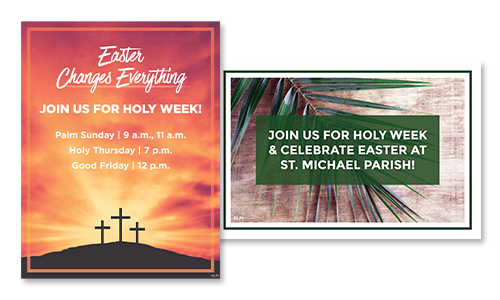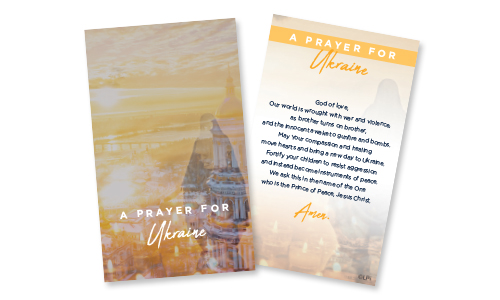In This Issue
March 2022
FEATURED ARTICLES
AT-A-GLANCE

THANK YOU and Survey Results
Hello friends!
My name is Danielle Center, I’m joining LPi with background in marketing, printing, and 10 years of Church experience in and with the Archdiocese of Detroit. I’m humbled to have a position that serves good people like you who are telling the world about Jesus Christ (I love him so much).
In January I worked with the team who surveyed you about the Vibrant Parish Newsletter (what you’re reading right now). We sought to understand what was working for you, and what we could improve for your enrichment. We learned that the Vibrant Parish Newsletter has a high open rate and that most of its readership is parish staff or very involved volunteers. We learned that you’re most interested in:
- Tips for engaging your parishioners
- Best practices for church communication — print and electronic
- And free content for you to share

With that in mind, the Vibrant Parish Newsletter will look different over the next few months. My goal is to continue to produce relevant and free content for you, feature more “real” parishes and parish staff, and to deliver messaging that is helpful and informative to your ministry.
To chat about any of this, comment on the survey findings, or tell me more about you and how we can better serve your community, drop me an email at [email protected].
I appreciate the opportunity to work alongside you as we tell the world that God is good, and that He loves everyone.
Praise God for His faithfulness!
Danielle Center

5 Ways to Welcome Visitors This Easter
Easter Sunday is a profound and sacred day on our Church calendar, and that spark of glory is sometimes partnered with guests visiting your church who aren’t regular church goers. Some folks may be members of your congregation who you see from time-to-time, others might be out-of-town family members or newcomers to the neighborhood.
In 1963, Rev. Dr. Martin Luther King Jr. famously said, “It is appalling that the most segregated hour of Christian America is 11 o’clock on Sunday,” a reference to churches traditionally being spaces of segregation instead of unity. Most communities don’t purposely exclude, but, in the words of Indian-American Rakhi McCormick, a convert to Catholicism from the Hindi faith of her family — inclusion won’t “just happen,” it needs to be something carefully considered, especially since the experience of many Catholics reflects Eurocentric expression, representation, and devotion.
How can your parish prepare for Easter Sunday and visitors who may feel out-of-place in your community?
Dr. Ansel Augustine, Director of the Office of Black Catholic Ministries for the Archdiocese of New Orleans, offered these 5 tips for making your parish a welcoming space that lives out Christ’s command to “Love one another as I have loved you.” (John 13:34)
Educate Ushers/ Ministers of Hospitality/ Parish Staff/ Ministry Leads on how to spot and welcome new people and families to Parish Events and Masses
- Remind your volunteers of the importance of their role during this season and review your current practices of welcome.
- Stay kind and be respectful of differences. Says Rakhi, “It seems a little trite but being greeted by parishioners and the pastor and asked my name — without a joke or reaction about it — is big.”
- Extend more options for encounter. Louis Brown, a Catholic from the Washington D.C. area encourages parishes to have opportunities of hospitality before and after Mass. Sure, some folks might rush off to brunch, but someone might want to discuss the experience they just had at your parish with someone who is willing to listen.

Create (or update!) Welcome Materials to give to visitors with parish information
- Start with your bulletin! Is the layout clean and attractive? Is the messaging targeted for those already “in” the parish? How can it be restructured to reflect invitation and hospitality? For instance: the term “RCIA” will be confusing for someone who isn’t Catholic already, so offer upbeat explanations where there may be gaps in knowledge.
- Consider a welcome card that outlines the ministries offered by your parish, invite visitors to leave prayer requests.
- Is everything in your bulletin in English when you have other languages represented in your parish boundaries? Something as small as a graphic in a native language can make a difference to a visitor.
- Consider dusting off your Mass aids. Remember: it may have been a few years since someone has been to Mass (if ever), and the flow of the liturgy isn’t exactly intuitive. Rakhi adds, “Mass aids that are simple (and not buried in a hymnal or missal) are another wonderful tool to encourage and welcome those who may not feel like they quite fit in. If they're available in a couple languages — even better!”
Collect their information … and follow up!
- Initial information that would be helpful for your staff is simple: first name, last name, phone number, email, are you baptized/Catholic (yes, no, unsure). Those simple answers will provide your staff with enough information to reach out later.
- Having paper cards printed out, with pens or pencils nearby, makes collection simple while your visitors are in church. Consider streamlining your online process as well by keeping your intake form simple and easy-to-find on your webpage.
- Don’t stop there! Consider writing a follow-up letter or email in the weeks that follow. A simple note expressing that you were glad they joined you on Easter is meaningful for your visitors.
Invite them to be added to the parish email list and invite them to join a ministry in the church
- Louis Brown stresses that, “Christ-centered community amongst existing parishioners in which they accompany each other day in and day out” is one of the best ways to encourage inclusion. Accompaniment that stretches into long-term friendship is a true mark of Christian love.
- Rakhi takes the message a step farther by stating that having a parish that is active not only in the works of mercy but also advocacy for the principles of Catholic Social Teaching for the marginalized can be a great indicator for BIPOC or other marginalized populations that the parish is authentically committed to justice and compassion.
Update the parish website so all the information is accurate and relevant
- It will only take a minute or two of your review, and it makes a world of a difference to someone new to your neighborhood. Did you change Mass from 10 to 10:30 a.m. 5 years ago but never updated your website? Make things as simple as possible for someone new to the area.
- “Where is overflow parking? Where is the main entrance?” These questions and more may be on your visitors’ mind, make sure they have access to the information they need when they visit your website.
While our faith and the joy of the Resurrection have been celebrated for centuries, Dr. Ansel Augustine reminds us all that this is a new time in the Church, “As the pandemic lifts, there may be more 'new folks' coming to our parishes in the hopes that our faith could help them make sense of this 'new normal,' let us be aware of this reality, by teaching and preaching to our congregations, that all are welcome in God's house, and to make sure that we engage with the new faces in a way that they feel welcomed and included in parish life.”

Engaging Volunteers: Is It a Generation Thing?
As much as we may not want to admit it, sometimes age is more than just a number. Generational differences shape our worldview, and we bring those characteristics with us to church. They can manifest in how we worship, how we serve and how we interact with the people and entities around us.
So, when building and activating an effective parish volunteer base, it’s important to take note of the different experiences and priorities inherent in each generational experience. A lifelong parishioner who still remembers the pre-Vatican II days will not have the same gifts and aspirations as a college student who loves devotional podcasts. Both volunteers bring their own charism to the job, equally important to your parish — but the act of engaging them in the work could look very different.
Baby Boomers (Born approximately 1946 to 1964)
It may be the case that this generation represents your parish’s “church elders,” but the chances are they don’t see themselves that way. For decades, the Baby Boomers represented the newness and youth of the “post-conciliar” liturgical and social movements, and that designation is a source of pride for many. Baby Boomers came of age during a time when lay involvement in parish administration was still controversial, and they want their contributions to matter. Boomers are either at or approaching retirement age, so they may find themselves with more free time to fill. They also represent a wealth of professional knowledge and expertise that can be useful to your parish. Boomers are also more financially well-off than their counterparts of previous generations so may be more open to financial stewardship than younger parishioners.
Gen X (Born approximately 1965 to 1980)

Gen X is often called “the forgotten generation,” sandwiched between the larger and more notorious Boomers and Millennials — but you definitely don’t want to forget about the Gen Xers at your parish. These folks are technologically literate, more likely to be college-educated than their parents, and are ascending to the peak of their professional careers. They are more likely than millennials to be religious and more likely to make room in their life for daily prayer, though the vast majority do not report being involved in any kind of regular religious study or education group. Chances are the Gen Xers in your parish are resourceful and well-connected, used to getting the job done without much supervision (they were the ones to give rise to the famous term “latchkey kid,” after all), and able to give more freely of their time and treasure than millennials.
Millennials (Born approximately 1980 to 1995)
Within Catholic circles, millennials often have the reputation of being more “traditionally minded” — but if that is true, it’s because millennials’ experience of the modern church and the world at large is often vastly different than their parents’ was. Millennials came of age in the wake of 9/11, as the economy crumbled, and the church was splashed across headlines in scandal after scandal. Churchgoing millennials are the exception to the rule, so they are unique among their friends or fellow Catholic school graduates in remaining observant. They are currently the biggest part of the American workforce so their time is often limited to the weekends and after work; at the same time, the majority of millennials earn less and carry more debt than previous generations, so they may see giving of their time as more feasible than giving monetarily.
Generation Z (Born approximately 1997-2012)
Despite being “digital natives” who likely don’t remember the days before the world was connected via social media, Gen Z-ers have a unique appreciation for the importance of meaningful human interaction. And while this generation may account for low church attendance rates, that doesn’t mean religion has no place in their lives. This group views the world through the lens of relationships. “If you ask any young person what they enjoy…their answer will be time spent with their peers, time doing things ‘that matter,’” said a priest involved in youth ministry. Research reports a low confidence in traditional institutions (including organized religions) but a high degree of confidence in those people and groups who make them feel heard. “One thing I heard for sure from Gen Z volunteers was: give us more responsibility,” said one parish leader. “Consult us. Don’t just tell us what you need. Let us be a part of the process.”
Volunteers are at the heart of our parishes, knowing a little about how the people of your church might approach volunteering will help you harness their power and build a more vibrant community. Check out New Ways to Recruit Parish Volunteers for some more valuable tips.

Sharing Easter Joy: Tips for reaching out to your neighborhood on Easter weekend
There was never a greater act of evangelization than the first Easter Sunday, when the empty tomb sent a clear message to the whole world: God is alive. Your parish wants to send that same message, always and everywhere — and Easter is the perfect time. However secular or commercialized the holiday has become, its religious roots are undeniable and ubiquitous. Seize the moment and look for ways to engage with the wider community during a time when your church enjoys a period of high visibility, simply by virtue of being a Christian organization on the biggest holiday weekend of the spring season.
Process!
Processions offer a compelling public witness to our faith, and these traditions are included in the rites of Holy Week and Easter liturgies (Palm Sunday, the Easter Vigil, etc.). Make the most of this opportunity and plan your processions in a way that makes them as conspicuous and eye-catching as possible. Incorporate as much music and beauty as you can and encourage as many parishioners to turn out as possible. Be sure to alert community newspapers of this photo op, too (see more on that below!).
Plan a service opportunity

There is no better time to mimic Christ’s example of service than Holy Week and Easter. Focus on hyperlocal opportunities that will create interaction with individuals and organizations in close physical proximity to your parish. Get creative and think outside of the box: have the youth group bake cookies for local law enforcement or send out flyers to residents in the surrounding blocks asking if anyone needs help with yardwork or chores. Call local senior centers and inquire if anyone needs transportation to Holy Thursday Liturgy. Explain the parish’s desire to share Easter joy and honor the self-giving love of our Savior … and let your acts of service do the rest of the talking.
Invite the community to Mass
Put up simple signage advertising Holy Week and Easter services and provide yard signs for parishioners to do likewise. Consider an eye-catching tagline like “Easter: Not Just About a Bunny!” Signs on the church property can use language that specifically welcomes newcomers or those who have been away from Mass — let it be known that all are welcome. Challenge each parishioner to lovingly (and without pressure) personally invite one person in their life to church this holiday.
Pitch a story idea to your local paper
Every parish is full of stories — what stories does yours have to share? Maybe it’s the 42nd consecutive year that Clem has played the organ at the Easter Vigil, or the fifth year that all three of the Smith kids have served at the Triduum services. Local newspapers love to hear timely human-interest pitches like these, and it’s a great opportunity for evangelization.
AT-A-GLANCE

Parish Websites for all Skill Levels
Does your church website need some attention, but you’re not sure where to start? WeConnect is designed for Catholic churches with easy setup, customizable layouts, and expert tech support.

FREE Easter & Holy Week Catholic graphics
Update your social media feeds, websites, or printed material with these free professional graphics. WeCreate offers beautiful Catholic graphics for your ministry communications.

Ukraine Graphics and Resources
With firm hope in the power of prayer, we unite our intentions for peace in communities around the world. These resources can be placed in bulletins, social media, or online as needed.

Looking for More Than “Just a Job”?
LPi is dedicated to helping churches, dioceses, non-profits, and their business advertisers succeed with cutting edge communication and engagement solutions. Besides providing a purpose and a paycheck, we offer a comprehensive benefit and compensation package designed to help you balance life and work.
In This Issue
March 2022
FEATURED ARTICLES
AT-A-GLANCE
More resources
- DIGITAL CATHOLIC ART & CONTENT FOR EVERY WEEK
With WeCreate, you’ll find the latest in stock photography, church clip art, Catholic prayers, weekly Gospel reflections, and more to make your communications engaging and vibrant.
Learn more - HOW TO TAKE MASS ATTENDANCE IN A PANDEMIC
Discover how the Archdiocese of St. Louis showed that just because church doors were closed, didn’t necessarily mean the faith community was inaccessible.
Click here to learn more. - THE STEWARDSHIP OF THE GOOD SAMARITAN
”Are you and I required to respond to the daily call of Jesus Christ? No. True stewardship requires nothing of us because true stewardship is all about giving of oneself freely. ”
Click here to read more.
